Carolee Schneemann
COURAGE. From the ‘Gift Science Archive’ guiding lights.
“That’s what I was recognizing when he was my student. He was all about spillage and seepage and everyone was trying to get him back in the quadrant and I thought that it was just perfect. Let him spill and seep and envelop and overcome space.” (Schneemann on Sands’ practice in the ‘Double Trouble’ catalog, 2001)
More
Carolee Schneemann’s work and her ways of being, ways of seeing and ways of understanding what “art” or “life” might be are imprinted into the DNA of Sands’ practice and of the ‘Gift Science Archive’. It would be impossible really to map that, so let’s start with a date and a title:
6 March. ‘Gift Science Archive’.
On 7 March 2019 Frédérique Bergholtz, Director of If I Can’t Dance, I Don’t Want To Be Part Of Your Revolution met with Sands to invite him to do a commission with If I Can’t Dance in the frame of their Edition VIII – ‘Ritual and Display’ biennial program. When she arrived at his home studio, she brought with her flowers. 7 March was the day that the death of Carolee Schneemann on 6 March 2019 became public knowledge. 6 March has in the three years of the ‘Gift Science Archive’ been a day of remembering to cherish the good company we are in, with our living ancestors and those passed beyond. Each year, on 6 March, in honor of Schneemann, the ‘Gift Science Archive’ has attempted what Aimar Arriola so beautifully articulated in ‘Process Event #2’: “to rhyme an end with a new beginning.”
When Frédérique approached Sands, he happily accepted and proposed to “take stock” of his 25-year studio practice; he proposed to take up the process of archiving as a performance; and he proposed to call this performance ‘Gift Science Archive’ after Schneemann’s 1965 ‘Gift Science’, an assemblage work bringing together objects gifted to her by other artists. The majority of objects constituting Schneemann’s (social) sculpture were gifts from men. The art world then (and still now) is dominated by men. BELONGING is complicated and contingent. With ‘Gift Science Archive’, Sands and the ‘Gift Science Archive’ team (all woman-identified) have playfully taken up Schneemann’s proposition of ‘gift science’ as a starting point to fuck with the scientific basis of an archiving system. No one on the team is trained in the library sciences, and none of us particularly care for sanitized, or “systematic” ways of thinking that push out the messy relationality—the spillage and the seepage—of the gift and the understandings of “value” and “economy”, which it engenders and enacts. Where is the space for non-systemic systems? It is Schneemann who opened up this space, first for Sands to have the courage and RESILIENCE to keep developing a practice as complicatedly conceptual and excessively emotional as his, even when, for decades, no one seemed to be looking; and second, for the ‘Gift Science Archive’ to come into being as a functioning archive of relations and their objects, as a collective of people and their positions, and as a fierce feminist demand to center feelings and thoughts and SHARING in our performances of history-making.
… I wonder, is this map enough to understand Carolee’s place in all of this? – MH.
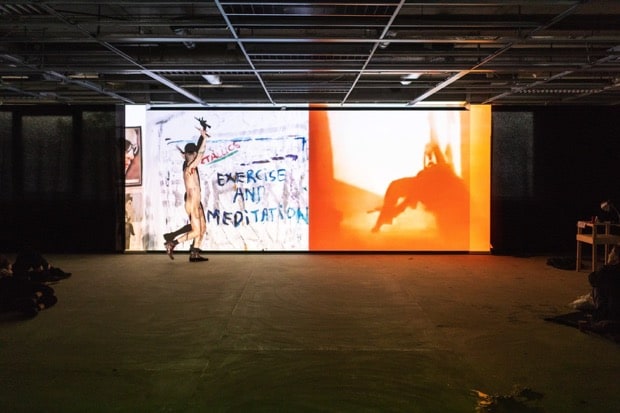


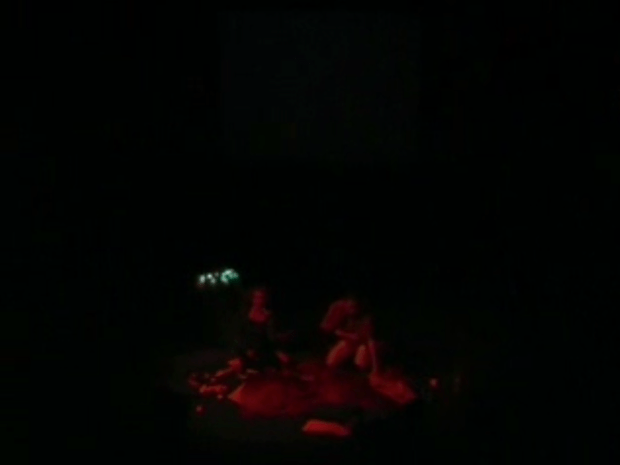


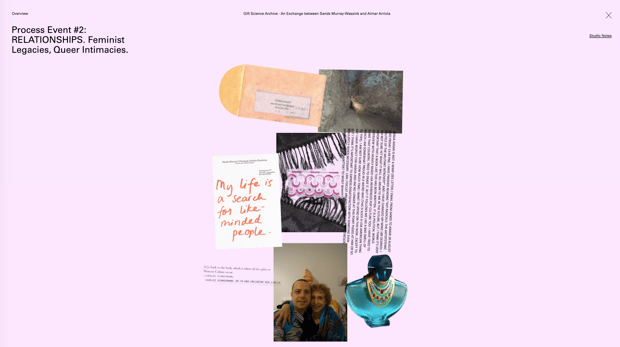


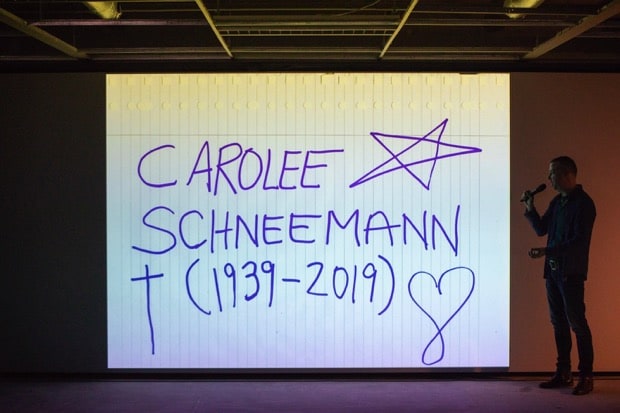

Image of Studio object

Photographer: Marcel de Buck
- Catalog No.
- 01567-2019-DoP-UpToAndIncludingHisLimits14
- Title
- Up To And Including His Limits
- Dimensions
- Variable
- Materials
- Live action and installation
- Object Location
- Digital
- Typology
- Sub-typology
- Grouping of work
- Social link(s)
- Year
- Technical Notes
Presentation for the If I Can’t Dance Edition VIII – Ritual and Display Introductory Kick-Off Weekend. The artist’s textile paintings adorn the space throughout the weekend. Here, he shares on his multimedia practice, concentrating on its early beginnings in 1993, in a slide show that makes clear his reliance on feminist figures like Carolee Schneeman, Hannah Wilke and Adrian Piper. He then dances before a dual projection – Schneemann video and footage from his studio – in and out of step with ‘Starlight’ by The Supermen Lovers.
Close
Image of Studio object

- Catalog No.
- 00432-2001-TwHd-YouCantImagine
- Title
- You Can't Imagine
- Dimensions
- 42 x 59
- Materials
- Poster marker, pen and coffee on paper
- Object Location
- Physical
- Typology
- Sub-typology
- Grouping of work
- Social link(s)
- Year
Close
Image of Studio object

Photographer: Megan Hoetger
- Catalog No.
- 01349-2020-MaPi-HangingTime-002
- Title
- Hanging Time
- Dimensions
- Variable
- Materials
- 50 phone snapshots
- Object Location
- Digital
- Typology
- Sub-typology
- Grouping of work
- Social link(s)
- Year
- Technical Notes
Date: 25.02.20. Location: Rijksakademie, studio manege. Images of installation activities in the studio, with SMW, MH and Roger Cremers who assists with hanging a large vinyl print and the framed work dedicated to Carolee Schneemann. Unpacking materials. Sands holding a drawing with a clock and 'tyranny' text, a gift for Roger. The beginnings of making the horse cloud on the studio wall.
Close
Image of Studio object

Photographer: Risk Hazekamp
- Catalog No.
- 00883-2001-DoP-LiveWithDoubleTrouble
- Title
- Live With Double Trouble: Carolee Schneemann and Sands Murray-Wassink
- Dimensions
- Variable
- Materials
- Live performance
- Object Location
- Digital
- Typology
- Sub-typology
- Social link(s)
- Year
- Technical Notes
Documentation of performance (color video with sound, 32:00) // duration of performance: 32:00. Location: Zaal de Unie, Rotterdam.
Close
Image of Studio object

- Catalog No.
- 00351-2000-PsW2000-ILOVECAROLEE
- Title
- I LOVE CAROLEE
- Dimensions
- 42 x 59
- Materials
- Poster marker on paper
- Object Location
- Physical
- Typology
- Sub-typology
- Grouping of work
- Social link(s)
- Year
- Reflection Notes
“When I am confronted by this much of my own past, my brain gets a bit overwhelmed.” – SMW.
Close
Image of Studio object

Photographer: Charlott Markus
- Catalog No.
- 01647-2021-DoE-InGoodCompany78
- Title
- In Good Company (Horsepower): Materials from the Gift Science Archive
- Dimensions
- Variable
- Materials
- Digital image files
- Object Location
- Digital
- Typology
- Sub-typology
- Social link(s)
- Year
- Technical Notes
SMW solo exhibition at mistral, Amsterdam (2021). The exhibition opens up the process of the ‘monumental’ 18-month collaborative performance Gift Science Archive (GSA) to the public for haptic engagements with the artist’s working and archiving processes. Visitors are invited to peruse the GSA archive database and to pull materials from the collection for a closer look and, over a cup, for a story. The ‘research experience’ is thus set into relational motion, by conversations – a central part of Murray-Wassink’s practice. Co-curated by Megan Hoetger (If I Can’t Dance) together with Radna Rumping and Huib Haye van der Werf (mistral).
Close
Image of Studio object

- Catalog No.
- 01493-2020/2021-DN-ProcessEvent#2RELATIONSHI…
- Title
- Process Event #2: RELATIONSHIPS. Feminist Legacies, Queer Intimacies
- Dimensions
- Variable
- Materials
- Epistolary exchange undertaken via email and published on ificantdance.studio
- Object Location
- Digital
- Sub-typology
- Grouping of work
- Social link(s)
- Year
- Technical Notes
The extended second process event in the three-part series featured an epistolary exchange between the artist and Bilbao-based curator Aimar Arriola. The exchange took place between June 2020 and February 2021, and – in process – was shared in www.ificantdance.studio between December 2020 and April 2021. From the ificantdance.studio: “Dipping in and out of a slow-time conversation between an artist and curator. To be read, whether chronologically or not, in an intimate space during moments alone”. – MH.
- Reflection Notes
“Starting Relationships in Pandemic Times. This, in truth, is a conversation largely, though not exclusively, carried out via emails that began on 10 June 2020. As we considered how we could continue working on Sands Murray-Wassink’s ambitious durational project Gift Science Archive, the looming realities of restricted travel and gathering weighed heavy in our minds. Crucial to Murray-Wassink and his collaborators’ performance of archiving/auto-archived performance is dialogue—indeed, the messy relationality of intrapersonal exchange is an organising principle for ‘the archive’ of Gift Science Archive.Following ‘Process Event #1: VALUE. What is trash? What is trashy but valuable?’ on 6 March 2020 (just one week before the lockdown in The Netherlands began), we were keen to start thinking toward a second process event that would highlight another keyword in the project and in Murray-Wassink’s practice more broadly: relationships. But this second process event went on hold along with everything else, first for a month, then for two and, in the end, for 81 days. From this nearly three months of lockdown grew the idea for an epistolary exchange, which was initiated by an invitation to Bilbao-based curator Aimar Arriola with whom If I Can’t Dance had previously worked in the frame of the 2008–2010 Edition III — Masquerade. The invitation read:Given your work on projects like the AIDS anarchive, as well as your numerous other curatorial and writing initiatives around queer visibility politics, we couldn’t think of a better person to invite for a conversation on the performance(s) of archiving.The event we initially had in mind was an in-person conversation that would have been held in the Rijksakademie studio/archive depot here in Amsterdam where Sands and I have been developing the project together with two other collaborators (Radna Rumping who is working with Sands on a meta-archive that documents the archiving process, and Amalia Calderón who is performing the roles of archivist and researcher in the archive as she inventories and reflects upon the materials uncovered). Such an event no longer seems possible or desirable at this historical juncture, and yet a conversation between you and Sands on these topics feels just as resonant as ever. With that in mind, we want to invite you to a conversation that would take place in a different spatial and temporal frame. What we have in mind is a dialogue that unfolds over the summer (stretching roughly from the end of June through the September) via emails and/or written letters in which you and Sands can share elements of your practices and address orienting questions on the above-cited themes (as a “moderator” of sorts, I could provide a few prompts to begin). This exchange would begin in late June with a letter from Sands, which he is developing as part of a mail art project with Foundation Perdu, a poetry bookshop and theatre space that has long been at the center of Amsterdam’s experimental arts scene. Sands’ letter would be a first introduction to his practice, and, we hope, could prompt some first responses from you. I must emphasize that this format is an experiment in event programming, as well as in feeling our way through other forms of intimacy. We at If I Can’t Dance are very eager to begin thinking how intimacy unfolds in different spaces and along different timelines; in particular, in the era of the coronavirus when so much of our lives seem to be moving so quickly online, we are keen to think together with our artist commissions and others in the arts how digital space might be a tool to slow things down rather than speed them up. Arriola graciously accepted. Another month or so passed. In late June Murray-Wassink’s Perdu letter went out. About one week later the conversation began. With time, the exchange has taken on the sub-title “Feminist Legacies, Queer Intimacies” These four keywords—feminist, legacies, queer, intimacies—are guiding terms that hold different resonance for Aimar and Sands. If for Sands ‘queer’ is a stumbling block, for Aimar intimacies is more difficult: How does queer mean? What does it have to do with sexuality? With sexual orientation? What is intimate but not necessarily private? What is intimacy without sexual contact? What would collective intimacy feel like? Such questions do not necessarily surface in the letters directly. Like a lot of the feelings or life questions that drive our calls and responses to one another, they appear between the commas and in other pauses of the breath.” – MH studio note from ificantdance.studio.
Close
Image of Studio object

- Catalog No.
- 00031-1993/1995-C-SignatureCollage-010
- Title
- Signature Collage
- Dimensions
- 21 x 29.5
- Materials
- Photocopy and oil crayon
- Object Location
- Physical
- Typology
- Grouping of work
- Social link(s)
- Year
- Reflection Notes
“Carolee. The collage is a foundation overview of where I come from and what was important to me – what still is. I cruise men sexually and I cruise women intellectually. My generation was a mess – when I talked about feminist art, nobody wanted to listen. I get suspicious when things are too cool i.e. feminism these days has this audience that rejected it before.” – SMW.
Close
Image of Studio object

- Catalog No.
- 00095-1993/1995-C-SignatureCollage-074
- Title
- Signature Collage
- Dimensions
- 21 x 29.5
- Materials
- Photocopy
- Object Location
- Physical
- Typology
- Grouping of work
- Social link(s)
- Year
- Reflection Notes
“Carolee with her partner Bruce MacPherson around 1978. I’m not sure what the dog’s book is. Collection of books, cassettes, etc. She looks happy. Coded handwriting in the back so that no one could read it; it reads ‘Carolee, Carolee, necessity’ and other things I can no longer decipher.” – SMW with AC.
Close
Image of Studio object

Photographer: Marcel de Buck
- Catalog No.
- 01559-2019-DoP-UpToAndIncludingHisLimits06
- Title
- Up To And Including His Limits
- Dimensions
- Variable
- Materials
- Live action and installation
- Object Location
- Digital
- Typology
- Sub-typology
- Grouping of work
- Social link(s)
- Year
- Technical Notes
Presentation for the If I Can’t Dance Edition VIII – Ritual and Display Introductory Kick-Off Weekend. The artist’s textile paintings adorn the space throughout the weekend. Here, he shares on his multimedia practice, concentrating on its early beginnings in 1993, in a slide show that makes clear his reliance on feminist figures like Carolee Schneeman, Hannah Wilke and Adrian Piper. He then dances before a dual projection – Schneemann video and footage from his studio – in and out of step with ‘Starlight’ by The Supermen Lovers.
Close
Image of Studio object

Photographer: Robin Wassink-Murray
- Catalog No.
- 02381-2019-FwPP-Carolee+Sands
- Title
- Carolee + Sands Magic Hair Pyramid & Working 2000 x 3
- Dimensions
- Variable
- Materials
- Construction in hand-carved, hand-gilded frame (triangle) and three framed signed works (rectangles) of photo collages printed from slides
- Object Location
- Physical
- Typology
- Sub-typology
- Social link(s)
- Year
- Technical Notes
“Above: Carolee had a knot in her hair. We were in her hotel room in Frankfurt where we met for her retrospective in 2017. She asked me if I could help to comb her hair and untangle the knot, and she insisted that Robin photograph it as a performance. Below: In 2000 in the first house that Robin and I shared together in Amsterdam, which was 19 square meters, I was on the phone arranging a purchase from Ronald Feldman Gallery of ‘Handle with Care,’ a work by Hannah Wilke. As Robin often does, he documented the action as a work.” – SMW.
Close
Listings connecting to the keyword “Carolee Schneemann” (254)
00892-2017…
Photographs
Performance…
Carolee Schneemann,…
2017
Image of Studio object

- Catalog No.
- 00892-2017-CP/PP-FaceFolder-003
- Title
- Face Folder
- Dimensions
- Variable
- Materials
- Digital image file
- Object Location
- Digital
- Typology
- Sub-typology
- Grouping of work
- Social link(s)
- Year
- Technical Notes
Self Portrait Images Ostensibly For Gay Internet Dating Sites (Planetromeo, etc.) Location: Swammerdamstraat Apartment Amsterdam, studio.
- Reflection Notes
From 12. April 2020 (WeTransfer notes): “they are a bit too close for me to properly ‘judge’, they are a bit neutral for me. Carolee always told me to go to where the difficulty was, and somehow my face has always been a challenging situation.” – SMW. 30. April 2020 (inventory note): “I also think of Jo Spence, the British artist, being told she was ‘brave’ for using her own image when she was not classically beautiful. And Carolee Schneemann and Hannah Wilke subverting the ‘ideal image’. I feel somewhere in between as I swing between ‘more ideal’ and ‘less ideal’.” – SMW.
Close
00973-2017…
Photographs
Performance…
Carolee Schneemann,…
2017
Image of Studio object

- Catalog No.
- 00973-2017-CP/PP-FaceFolder-084
- Title
- Face Folder
- Dimensions
- Variable
- Materials
- Digital image file
- Object Location
- Digital
- Typology
- Sub-typology
- Grouping of work
- Social link(s)
- Year
- Technical Notes
Self Portrait Images Ostensibly For Gay Internet Dating Sites (Planetromeo, etc.) Location: Swammerdamstraat Apartment Amsterdam, studio.
- Reflection Notes
From 12. April 2020 (WeTransfer notes): “they are a bit too close for me to properly ‘judge’, they are a bit neutral for me. Carolee always told me to go to where the difficulty was, and somehow my face has always been a challenging situation.” – SMW. 30. April 2020 (inventory note): “I also think of Jo Spence, the British artist, being told she was ‘brave’ for using her own image when she was not classically beautiful. And Carolee Schneemann and Hannah Wilke subverting the ‘ideal image’. I feel somewhere in between as I swing between ‘more ideal’ and ‘less ideal’.” – SMW.
Close
01043-2020…
Photographs
Performance…
Carolee Schneemann,…
2020
Image of Studio object
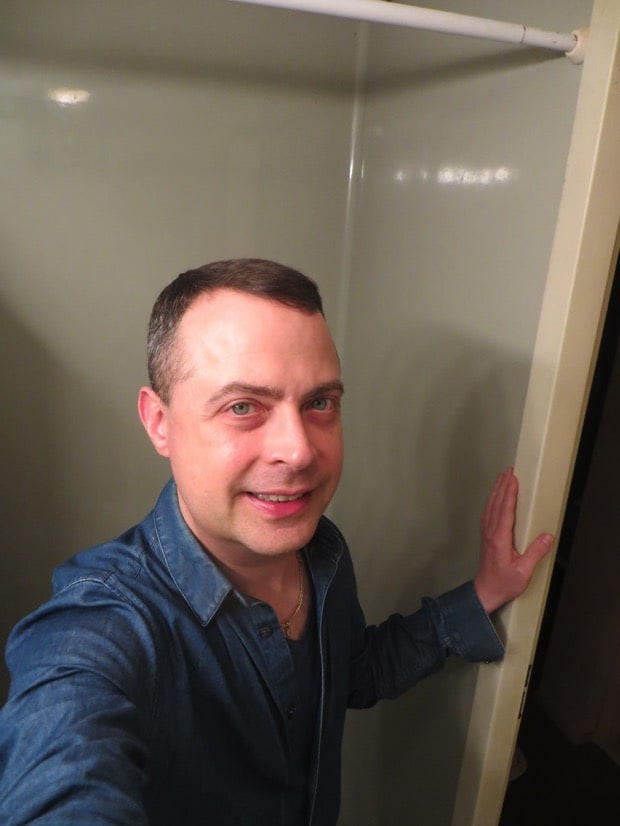
- Catalog No.
- 01043-2020-CP/PP-NewFaceFolder-066
- Title
- New Face Folder
- Dimensions
- Variable
- Materials
- Digital image file
- Object Location
- Digital
- Typology
- Sub-typology
- Grouping of work
- Social link(s)
- Year
- Technical Notes
Self Portrait Images Ostensibly For Gay Internet Dating Sites (Planetromeo, etc.) Location: Swammerdamstraat Apartment Amsterdam, shower room.
- Reflection Notes
From 12. April 2020 (WeTransfer notes): “they are a bit too close for me to properly ‘judge’, they are a bit neutral for me. Carolee always told me to go to where the difficulty was, and somehow my face has always been a challenging situation.” – SMW. 30. April 2020 (inventory note): “I also think of Jo Spence, the British artist, being told she was ‘brave’ for using her own image when she was not classically beautiful. And Carolee Schneemann and Hannah Wilke subverting the ‘ideal image’. I feel somewhere in between as I swing between ‘more ideal’ and ‘less ideal’.” – SMW.
Close
01565-2019…
Photographs
Documentation of…
Carolee Schneemann
2019
Image of Studio object
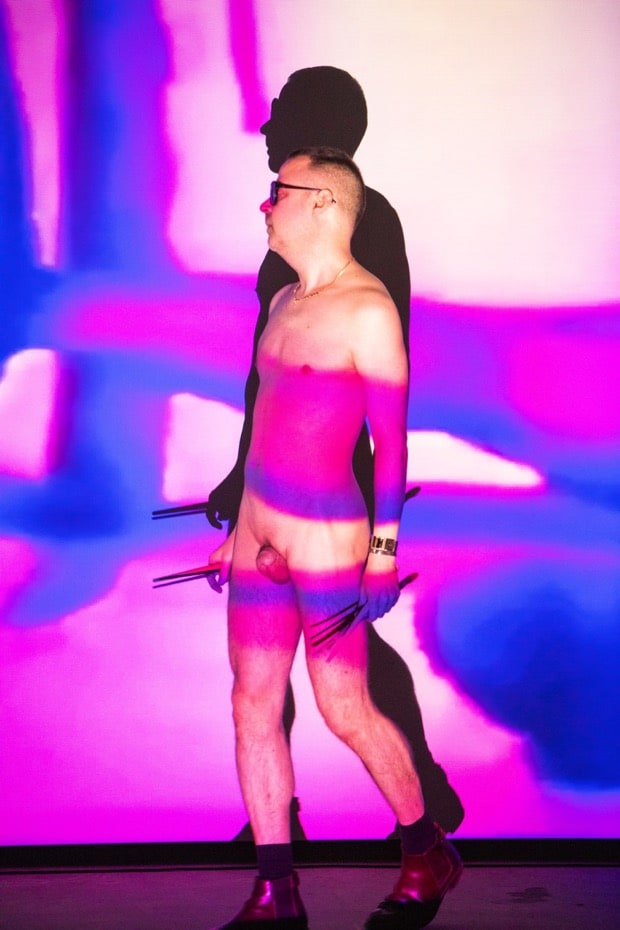
Photographer: Marcel de Buck
- Catalog No.
- 01565-2019-DoP-UpToAndIncludingHisLimits12
- Title
- Up To And Including His Limits
- Dimensions
- Variable
- Materials
- Live action and installation
- Object Location
- Digital
- Typology
- Sub-typology
- Grouping of work
- Social link(s)
- Year
- Technical Notes
Presentation for the If I Can’t Dance Edition VIII – Ritual and Display Introductory Kick-Off Weekend. The artist’s textile paintings adorn the space throughout the weekend. Here, he shares on his multimedia practice, concentrating on its early beginnings in 1993, in a slide show that makes clear his reliance on feminist figures like Carolee Schneeman, Hannah Wilke and Adrian Piper. He then dances before a dual projection – Schneemann video and footage from his studio – in and out of step with ‘Starlight’ by The Supermen Lovers.
Close
01597-2021…
Photographs
Documentation of…
Adrian Piper, Carolee…
2021
Image of Studio object

Photographer: Charlott Markus
- Catalog No.
- 01597-2021-DoE-InGoodCompany28
- Title
- In Good Company (Horsepower): Materials from the Gift Science Archive
- Dimensions
- Variable
- Materials
- Digital image files
- Object Location
- Digital
- Typology
- Sub-typology
- Social link(s)
- Year
- Technical Notes
SMW solo exhibition at mistral, Amsterdam (2021). The exhibition opens up the process of the ‘monumental’ 18-month collaborative performance Gift Science Archive (GSA) to the public for haptic engagements with the artist’s working and archiving processes. Visitors are invited to peruse the GSA archive database and to pull materials from the collection for a closer look and, over a cup, for a story. The ‘research experience’ is thus set into relational motion, by conversations – a central part of Murray-Wassink’s practice. Co-curated by Megan Hoetger (If I Can’t Dance) together with Radna Rumping and Huib Haye van der Werf (mistral).
Close
00001-2014…
Thought works
Rolled painting
Carolee Schneemann
2014
Image of Studio object

- Catalog No.
- 00001-2014-TwRp-MeetYourOwnNeeds
- Title
- Meet Your Own Needs
- Dimensions
- 150 x 70
- Materials
- Acrylic on paper
- Object Location
- Physical
- Typology
- Sub-typology
- Grouping of work
- Social link(s)
- Year
- Reflection Notes
Performative actions to exorcise negative thoughts.
Close
01260-2000…
Philosophical…
Working 2000
Carolee Schneemann
2000
Image of Studio object

- Catalog No.
- 01260-2000-`PsW2000-MyHumblePlace
- Title
- My Humble Place
- Dimensions
- 42 x 59
- Materials
- Poster marker on paper
- Object Location
- Physical
- Typology
- Sub-typology
- Grouping of work
- Social link(s)
- Year
Close
01629-2021…
Photographs
Documentation of…
Adrian Piper, Carolee…
2021
Image of Studio object

Photographer: Charlott Markus
- Catalog No.
- 01629-2021-DoE-InGoodCompany60
- Title
- In Good Company (Horsepower): Materials from the Gift Science Archive
- Dimensions
- Variable
- Materials
- Digital image files
- Object Location
- Digital
- Typology
- Sub-typology
- Social link(s)
- Year
- Technical Notes
SMW solo exhibition at mistral, Amsterdam (2021). The exhibition opens up the process of the ‘monumental’ 18-month collaborative performance Gift Science Archive (GSA) to the public for haptic engagements with the artist’s working and archiving processes. Visitors are invited to peruse the GSA archive database and to pull materials from the collection for a closer look and, over a cup, for a story. The ‘research experience’ is thus set into relational motion, by conversations – a central part of Murray-Wassink’s practice. Co-curated by Megan Hoetger (If I Can’t Dance) together with Radna Rumping and Huib Haye van der Werf (mistral).
Close
01661-2021…
Photographs
Documentation of…
Adrian Piper, Carolee…
2021
Image of Studio object

Photographer: Charlott Markus
- Catalog No.
- 01661-2021-DoE-InGoodCompany92
- Title
- In Good Company (Horsepower): Materials from the Gift Science Archive
- Dimensions
- Variable
- Materials
- Digital image files
- Object Location
- Digital
- Typology
- Sub-typology
- Social link(s)
- Year
- Technical Notes
SMW solo exhibition at mistral, Amsterdam (2021). The exhibition opens up the process of the ‘monumental’ 18-month collaborative performance Gift Science Archive (GSA) to the public for haptic engagements with the artist’s working and archiving processes. Visitors are invited to peruse the GSA archive database and to pull materials from the collection for a closer look and, over a cup, for a story. The ‘research experience’ is thus set into relational motion, by conversations – a central part of Murray-Wassink’s practice. Co-curated by Megan Hoetger (If I Can’t Dance) together with Radna Rumping and Huib Haye van der Werf (mistral).
Close
00614-2009…
Photographs
Documentation of…
Carolee Schneemann,…
2009
Image of Studio object

- Catalog No.
- 00614-2009-DoP-TalkingWithPaintings-02
- Title
- Talking with Paintings
- Dimensions
- Variable
- Materials
- Live action
- Object Location
- Digital
- Typology
- Sub-typology
- Grouping of work
- Social link(s)
- Year
- Technical Notes
Photographs in collaboration with Johanna Braun. Location: Johanna Braun’s apartment, Vienna, Austria, first district. Photographer: Unknown.
- Reflection Notes
From 27. April (WeTransfer notes): “The other 11 images are from 2009 as well. They were taken in Vienna and are a performance with artist Johanna Braun where I am both art historian and nude, and Johanna and I perform together discussing her work. This was based on a 1969 work by Carolee Schneemann in London called ‘Naked Action Lecture’ where she was art historian of her own work in a slide show and got naked at a certain point to see if she could keep her authority.” – SMW.
Close
00903-2017…
Photographs
Performance…
Carolee Schneemann,…
2017
Image of Studio object

- Catalog No.
- 00903-2017-CP/PP-FaceFolder-014
- Title
- Face Folder
- Dimensions
- Variable
- Materials
- Digital image file
- Object Location
- Digital
- Typology
- Sub-typology
- Grouping of work
- Social link(s)
- Year
- Technical Notes
Self Portrait Images Ostensibly For Gay Internet Dating Sites (Planetromeo, etc.) Location: Swammerdamstraat Apartment Amsterdam, studio.
- Reflection Notes
From 12. April 2020 (WeTransfer notes): “they are a bit too close for me to properly ‘judge’, they are a bit neutral for me. Carolee always told me to go to where the difficulty was, and somehow my face has always been a challenging situation.” – SMW. 30. April 2020 (inventory note): “I also think of Jo Spence, the British artist, being told she was ‘brave’ for using her own image when she was not classically beautiful. And Carolee Schneemann and Hannah Wilke subverting the ‘ideal image’. I feel somewhere in between as I swing between ‘more ideal’ and ‘less ideal’.” – SMW.
Close
01004-2020…
Photographs
Performance…
Carolee Schneemann, Jo…
2020
Image of Studio object

- Catalog No.
- 01004-2020-CP/PP-NewFaceFolder-026
- Title
- New Face Folder
- Dimensions
- Variable
- Materials
- Digital image file
- Object Location
- Digital
- Typology
- Sub-typology
- Grouping of work
- Social link(s)
- Year
- Technical Notes
Self Portrait Images Ostensibly For Gay Internet Dating Sites (Planetromeo, etc.) Location: Swammerdamstraat Apartment Amsterdam, shower room.
- Reflection Notes
From 12. April 2020 (WeTransfer notes): “they are a bit too close for me to properly ‘judge’, they are a bit neutral for me. Carolee always told me to go to where the difficulty was, and somehow my face has always been a challenging situation.” – SMW. 30. April 2020 (inventory note): “I also think of Jo Spence, the British artist, being told she was ‘brave’ for using her own image when she was not classically beautiful. And Carolee Schneemann and Hannah Wilke subverting the ‘ideal image’. I feel somewhere in between as I swing between ‘more ideal’ and ‘less ideal’.” – SMW.
Close
01576-2021…
Photographs
Documentation of…
Adrian Piper, Carolee…
2021
Image of Studio object

Photographer: Charlott Markus
- Catalog No.
- 01576-2021-DoE-InGoodCompany07
- Title
- In Good Company (Horsepower): Materials from the Gift Science Archive
- Dimensions
- Variable
- Materials
- Digital image files
- Object Location
- Digital
- Typology
- Sub-typology
- Social link(s)
- Year
- Technical Notes
SMW solo exhibition at mistral, Amsterdam (2021). The exhibition opens up the process of the ‘monumental’ 18-month collaborative performance Gift Science Archive (GSA) to the public for haptic engagements with the artist’s working and archiving processes. Visitors are invited to peruse the GSA archive database and to pull materials from the collection for a closer look and, over a cup, for a story. The ‘research experience’ is thus set into relational motion, by conversations – a central part of Murray-Wassink’s practice. Co-curated by Megan Hoetger (If I Can’t Dance) together with Radna Rumping and Huib Haye van der Werf (mistral).
Close
01608-2021…
Photographs
Documentation of…
Adrian Piper, Carolee…
2021
Image of Studio object

Photographer: Charlott Markus
- Catalog No.
- 01608-2021-DoE-InGoodCompany39
- Title
- In Good Company (Horsepower): Materials from the Gift Science Archive
- Dimensions
- Variable
- Materials
- Digital image files
- Object Location
- Digital
- Typology
- Sub-typology
- Social link(s)
- Year
- Technical Notes
SMW solo exhibition at mistral, Amsterdam (2021). The exhibition opens up the process of the ‘monumental’ 18-month collaborative performance Gift Science Archive (GSA) to the public for haptic engagements with the artist’s working and archiving processes. Visitors are invited to peruse the GSA archive database and to pull materials from the collection for a closer look and, over a cup, for a story. The ‘research experience’ is thus set into relational motion, by conversations – a central part of Murray-Wassink’s practice. Co-curated by Megan Hoetger (If I Can’t Dance) together with Radna Rumping and Huib Haye van der Werf (mistral).
Close
01640-2021…
Photographs
Documentation of…
Adrian Piper, Carolee…
2021
Image of Studio object

Photographer: Charlott Markus
- Catalog No.
- 01640-2021-DoE-InGoodCompany71
- Title
- In Good Company (Horsepower): Materials from the Gift Science Archive
- Dimensions
- Variable
- Materials
- Digital image files
- Object Location
- Digital
- Typology
- Sub-typology
- Social link(s)
- Year
- Technical Notes
SMW solo exhibition at mistral, Amsterdam (2021). The exhibition opens up the process of the ‘monumental’ 18-month collaborative performance Gift Science Archive (GSA) to the public for haptic engagements with the artist’s working and archiving processes. Visitors are invited to peruse the GSA archive database and to pull materials from the collection for a closer look and, over a cup, for a story. The ‘research experience’ is thus set into relational motion, by conversations – a central part of Murray-Wassink’s practice. Co-curated by Megan Hoetger (If I Can’t Dance) together with Radna Rumping and Huib Haye van der Werf (mistral).
Close